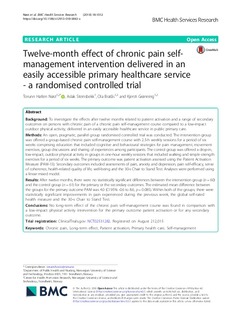| dc.contributor.author | Nøst, Torunn Hatlen | |
| dc.contributor.author | Steinsbekk, Aslak | |
| dc.contributor.author | Bratås, Ola | |
| dc.contributor.author | Grønning, Kjersti | |
| dc.date.accessioned | 2019-01-04T12:14:19Z | |
| dc.date.available | 2019-01-04T12:14:19Z | |
| dc.date.created | 2019-01-02T14:20:33Z | |
| dc.date.issued | 2018 | |
| dc.identifier.citation | BMC Health Services Research. 2018, 18 . | nb_NO |
| dc.identifier.issn | 1472-6963 | |
| dc.identifier.uri | http://hdl.handle.net/11250/2579204 | |
| dc.description.abstract | Background: To investigate the effects after twelve months related to patient activation and a range of secondary outcomes on persons with chronic pain of a chronic pain self-management course compared to a low-impact outdoor physical activity, delivered in an easily accessible healthcare service in public primary care. Methods: An open, pragmatic, parallel group randomised controlled trial was conducted. The intervention group was offered a group-based chronic pain self-management course with 2.5-h weekly sessions for a period of six weeks comprising education that included cognitive and behavioural strategies for pain management, movement exercises, group discussions and sharing of experiences among participants. The control group was offered a drop-in, low-impact, outdoor physical activity in groups in one-hour weekly sessions that included walking and simple strength exercises for a period of six weeks. The primary outcome was patient activation assessed using the Patient Activation Measure (PAM-13). Secondary outcomes included assessments of pain, anxiety and depression, pain self-efficacy, sense of coherence, health-related quality of life, well-being and the 30-s Chair to Stand Test. Analyses were performed using a linear mixed model. Results: After twelve months, there were no statistically significant differences between the intervention group (n=60) and the control group (n=61) for the primary or the secondary outcomes. The estimated mean difference between the groups for the primary outcome PAM was 4.0 (CI 95% -0.6 to 8.6, p=0.085). Within both of the groups, there were statistically significant improvements in pain experienced during the previous week, the global self-rated health measure and the 30-s Chair to Stand Test. Conclusions: No long-term effect of the chronic pain self-management course was found in comparison with a low-impact physical activity intervention for the primary outcome patient activation or for any secondary outcome. | nb_NO |
| dc.language.iso | eng | nb_NO |
| dc.publisher | BMC (part of Springer Nature) | nb_NO |
| dc.rights | Navngivelse 4.0 Internasjonal | * |
| dc.rights.uri | http://creativecommons.org/licenses/by/4.0/deed.no | * |
| dc.title | Twelve-month effect of chronic pain self-management intervention delivered in an easily accessible primary healthcare service - a randomised controlled trial | nb_NO |
| dc.type | Journal article | nb_NO |
| dc.type | Peer reviewed | nb_NO |
| dc.description.version | publishedVersion | nb_NO |
| dc.source.pagenumber | 15 | nb_NO |
| dc.source.volume | 18 | nb_NO |
| dc.source.journal | BMC Health Services Research | nb_NO |
| dc.identifier.doi | 10.1186/s12913-018-3843-x | |
| dc.identifier.cristin | 1648728 | |
| dc.relation.project | Norges forskningsråd: 238331 | nb_NO |
| dc.description.localcode | © The Author(s). 2018 Open Access This article is distributed under the terms of the Creative Commons Attribution 4.0 International License (http://creativecommons.org/licenses/by/4.0/) | nb_NO |
| cristin.unitcode | 194,65,20,0 | |
| cristin.unitname | Institutt for samfunnsmedisin og sykepleie | |
| cristin.ispublished | true | |
| cristin.fulltext | original | |
| cristin.qualitycode | 2 | |

